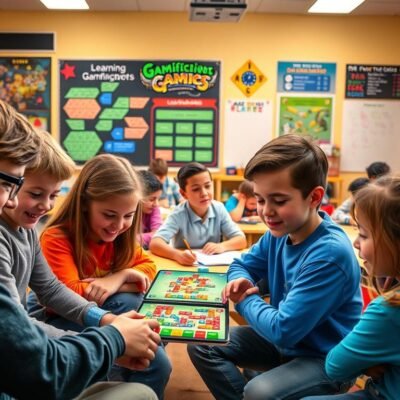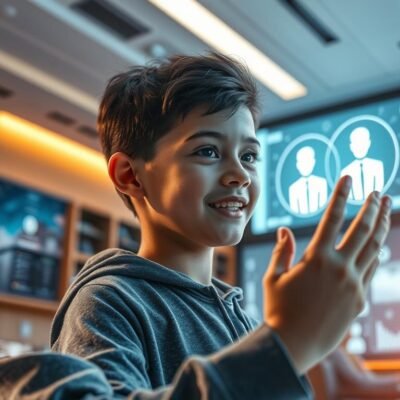
Imagine attending a virtual class where videos load instantly, group projects feel lifelike, and lag-free lectures keep you engaged. This isn’t science fiction—it’s the reality next-gen wireless networks are creating for digital classrooms. With speeds 100 times faster than older systems, 5G eliminates buffering and latency issues that once frustrated remote learners.
Recent data shows over 1 billion people will access this technology by 2023. During pandemic lockdowns, schools relying on 4G struggled with frozen screens and dropped connections. Now, high-speed connectivity lets students collaborate in real time, even when continents apart. Interactive simulations and augmented reality tools—once limited by bandwidth—are becoming standard in modern lesson plans.
Educators report smoother transitions to hybrid models thanks to reliable video streaming. Rural areas previously hindered by weak signals now access the same resources as urban institutions. As networks expand, experts predict a surge in global enrollment for specialized courses requiring robust tech support.
This advancement isn’t just about quicker downloads. It’s reshaping how knowledge gets shared, breaking down barriers between teachers and learners worldwide. The classroom of tomorrow might exist entirely in virtual space—and it’s arriving faster than you think.
Key Takeaways
- 5G enables instant video loading and real-time collaboration in virtual classrooms
- Global adoption rates are accelerating, with 1 billion users expected by 2023
- Rural education access improves through stronger network reliability
- Augmented reality tools become practical for daily lessons
- Hybrid learning models benefit from consistent connectivity
- Specialized courses gain wider accessibility across borders
Introduction to 5G in Education
Think back to buffering videos during lectures—those interruptions are becoming history. Mobile networks have transformed from basic call services to powerful educational tools. Let’s explore how this shift happened and why it’s changing learning forever.
The Evolution of Mobile Networks
Remember 2G? It brought texts and pixelated images to flip phones. Then came 3G, letting you check email on the go. 4G upgraded video streaming, but classrooms still faced laggy virtual sessions.
Now, 5G acts like a superhighway for educational platforms. With speeds up to 10 Gbps, it transfers large files faster than you blink. Schools using older networks struggled with 15+ students on video calls. Today’s tech handles 100+ connections without hiccups.
Why 5G Matters in Today’s Digital Learning Landscape
Here’s the secret sauce: millimeter wave spectrum and beamforming. These features let educational institutions deliver 3D anatomy models or live VR field trips. No more “Can you hear me?” moments during group projects.
Students in rural areas now access the same resources as city peers. A recent study shows 5G reduces latency by 90%, making real-time collaboration feel natural. Teachers report smoother hybrid classes where everyone participates equally.
This isn’t just faster internet—it’s a bridge between textbooks and interactive worlds. Your learning experience now adapts to your pace, location, and needs.
The impact of 5G on online education delivery
Remember when frozen screens ruined your lesson flow? Those days are vanishing as next-gen connectivity reshapes digital classrooms. Institutions now deploy advanced networks to eliminate technical hiccups, creating environments where focus stays on knowledge absorption.

From Disruptions to Seamless Learning Experiences
Gone are the days of waiting minutes for a 4K lecture video to load. With network speeds rivaling wired connections, learners instantly access HD content. A biology student can dissect 3D models in real time while their peer in another state collaborates via lag-free video chat.
Attendance spikes tell the story. Schools using this tech report near-perfect participation rates—even during snowstorms or transit delays. “Mobile access changed everything,” notes a Chicago district superintendent. “Kids join from buses or waiting rooms without missing a beat.”
Here’s what you’ll gain:
- Zero buffering during live demos or guest speaker sessions
- Instant downloads of 500MB lab simulation files
- Consistent connectivity for rural learners previously stuck with spotty signals
Educators also win. Automated systems distribute materials simultaneously to all devices, while AI-driven analytics track comprehension patterns. The result? Lessons adapt faster to class needs, and technical issues fade into the background where they belong.
Enhancing Interactive Learning Experiences
Picture a biology class where beating hearts float above desks. Students rotate holographic organs with gestures, while their instructor annotates structures in mid-air. This is the new frontier of digital instruction—where augmented reality applications turn abstract ideas into tangible discoveries.
Augmented and Virtual Reality in the Classroom
Next-gen networks erase the jittery movements that once plagued VR headsets. Medical trainees now practice virtual surgeries with precise hand tracking, while engineering students disassemble 3D engine models layer by layer. “The latency reduction feels like switching from dial-up to broadband,” remarks a UCLA simulation lab director.
These technologies shine in technical fields. Automotive repair classes project digital overlays onto physical car parts, showing hidden systems. Healthcare programs use VR to simulate emergency room triage, building decision-making skills under pressure.
High-Quality Video Conferencing and Immersive Tools
Crisp 4K streams make remote collaborators feel present in your workspace. Two students split across time zones can tweak the same CAD design simultaneously, watching changes unfold in real time. No more pixelated faces or robotic voices breaking concentration.
Educators gain fresh tools to spark curiosity. Live-stream archaeological digs, interactive molecular modeling sessions, or global expert panels—all flow smoothly. Your lesson plans evolve beyond slideshows, letting learners manipulate concepts rather than just view them.
Boosting Communication and Collaboration
Ever tried explaining a complex concept while your student’s screen freezes mid-sentence? Those cringe-worthy moments fade with next-gen connectivity. Networks now deliver crystal-clear interactions, letting ideas flow without technical hiccups.

Real-Time Connectivity and Low Latency Benefits
Imagine answering a raised hand before the student lowers it. Low latency makes this possible, shrinking response times to under 10 milliseconds. You’ll notice conversations flowing like in-person chats, whether discussing calculus proofs or Shakespearean themes.
Rural learners no longer miss key points due to spotty signals. A teacher in Montana shares, “My class debates now feel lively—no one’s stuck buffering while making arguments.” Group projects thrive as students edit shared documents simultaneously, with changes appearing instantly for all collaborators.
Three ways this transforms your classroom:
- Instant feedback loops during virtual office hours
- Smooth video conferences with 8K clarity
- Always-available portals for homework questions
You’ll build stronger bonds with learners through spontaneous check-ins. Midnight study groups form naturally when connectivity feels like shared physical space. This isn’t just faster internet—it’s rewriting how knowledge gets exchanged.
Expanding Access and Personalized Learning
Picture a student in rural Wyoming accessing MIT lectures while their peer in downtown Boston joins from a subway train. Next-gen connectivity makes this possible, turning every location into a potential classroom. Geographic barriers crumble as high-speed networks deliver equal learning opportunities to urban apartments and mountain towns alike.
Bridging the Digital Divide
Schools once limited by spotty signals now stream 4K tutorials to mobile devices. A teacher in Appalachia shares, “My students finally access the same resources as coastal districts.” Over 4,500 EdTech platforms now serve 300 million learners globally—many in regions previously lacking quality instructors.
Specialized tools thrive in this environment. Real-time translation breaks language barriers, while assistive technologies convert lectures into Braille-compatible formats. Students with hearing challenges get instant captions, and those needing extra help replay complex concepts via on-demand videos.
Adaptive Learning Tools and Customized Educational Resources
Your lesson plans now evolve with each student’s progress. AI-powered systems analyze performance patterns, serving personalized quizzes and explanatory clips. Competitive exam pass rates jumped from 1% to 7% where these tools get implemented.
Three key changes you’ll notice:
- Self-paced modules let night owls and early birds thrive equally
- Global course libraries replace outdated textbooks
- Instant feedback loops identify knowledge gaps before tests
This isn’t just about faster connections—it’s creating growth pathways tailored to individual strengths. Your classroom becomes a launchpad where every learner finds their unique route to success.
Conclusion
Envision students in remote villages joining Ivy League seminars while city peers collaborate via holographic whiteboards. This isn’t tomorrow’s dream—it’s today’s educational reality, powered by networks that make lag and buffering relics of the past.
You’re witnessing a learning revolution where AI tutors adjust lessons mid-stream and VR labs replace textbook diagrams. Pandemic challenges accelerated tech adoption, but next-gen connectivity solves deeper issues—like bridging resource gaps between urban and rural schools.
Classrooms now extend beyond physical walls. A biology major in Nebraska can manipulate 3D cell models while a peer in Mumbai annotates shared screens. Teachers gain tools to track progress in real time, offering help before frustration sets in.
The fusion of lightning-fast networks, adaptive platforms, and immersive tech creates equal opportunities globally. Whether accessing rare archival materials or joining live coding bootcamps, geographical limits no longer dictate educational access.
Your role in this transformed landscape? Embrace tools that make knowledge fluid and collaborative. Because when connectivity barriers fall, every curious mind gets front-row seats to humanity’s collective wisdom.



